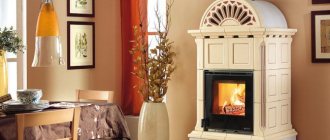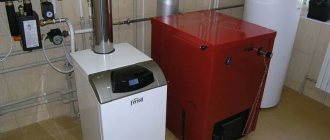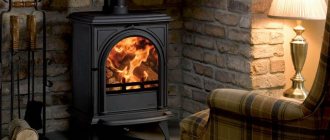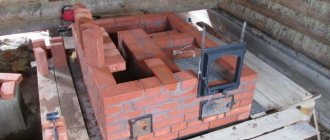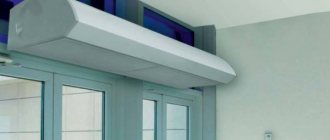A fan heater is a fairly simple and effective heating device that enjoys well-deserved popularity among consumers. This device will not only allow you to quickly warm up the room during the off-season, but will also be able to maintain the temperature within user-specified limits. The variety of types, types and designs creates a certain difficulty for a potential buyer in choosing the necessary device. We will tell you how to choose a good fan heater and what you should pay attention to when purchasing this device.
Design and principle of operation
A fan heater is a compact heater that heats the air passing through it. This device can be the only source of heat or used in addition to the main heating system.
The simplest design of a heat fan includes four required elements:
- frame;
- a heating element;
- Control block;
- fan.
Optionally, the standard package may include various climate sensors, a thermostat, an engine speed controller, an air humidifier, filter elements, a rotating mechanism, etc.
The operating principle of this device is simple: the fan takes cooled air from the room, directing it through the built-in heating element. Next, the already heated air flow flows from the device back into the room.
Exploitation
To ensure that the device lasts as long as possible, follow some operating rules.
- Periodically wipe off dust from the surface of the heat fan housing.
- Clean grilles that collect air using a vacuum cleaner.
- Regular inspection will help prevent malfunctions.
Pay special attention to operating rules related to fire safety:
- Before cleaning the fan, disconnect it from the power supply and wait until it cools down.
- The fan heater must not be connected to the electrical network without grounding.
- The fan heater must not be used in rooms with air humidity exceeding 93%, in a chemical or explosive environment.
- Do not drop the fan heater or handle it by the power cord.
- Before each connection, check the integrity of the wire.
- It is not safe to use the fan heater in close proximity to water, even if it has a splash-proof function.
- Do not install the fan on carpet.
- Under no circumstances should the fan be covered with fabrics or obstruct the air flow, as this may lead to a fire.
- If the fan is not a ceiling fan, operating it in a horizontal position is also unsafe: the plastic housing will melt or catch fire.
- There should be at least half a meter between the fan heater and the nearest objects.
- The appearance of sparks and too frequent operation of the temperature regulator indicate a malfunction. The fan heater cannot be used in this condition.
Classification of fan heaters
Fan heaters are classified according to three main characteristics: scope of application, installation method and purpose. Let's look at them in more detail.
By area of application
All fan heaters can be divided into two large groups:
- Industrial.
Industrial fan heaters (hereinafter referred to as heat guns) can use electricity, energy from combustion gas, diesel fuel, and hot water to heat air masses. Heat guns are equipped with temperature control sensors and power adjustment. More “advanced” models, in addition to basic elements, have a built-in emergency shutdown unit, a fan rotation mechanism, and the ability to connect air ducts for heating several rooms.
The housing of industrial designs is made primarily of metal with a mandatory thermal insulation layer, which prevents injuries during operation of the devices.
- Household.
Household models use heating elements that run on electricity. The power of household fan heaters is limited by the capabilities of the power lines and therefore rarely exceeds 2.5 kW. The housing of household devices is made of impact-resistant, heat-resistant plastic.
Household fan heaters
Industrial fan heaters
By the nature of the installation
According to the installation method, all heat fans are divided into stationary and portable models.
Stationary
This group includes devices with the following installation options:
- Floor-standing. Floor-standing devices are characterized by the presence of a supporting structure, which allows air intake directly through the lower grille in the device body. Some models are equipped with a rotating mechanism for better heat distribution throughout the room.
- Tabletop . This type of installation requires small dimensions and weight of the device.
- Wall-mounted ones most often have a horizontal orientation and can be equipped with rotating curtains that direct the heated air flow to a certain point in the room. Can be used as a thermal curtain. Most often, they are equipped with a remote control unit.
- Ceiling . Devices of this design are equipped with special mounts that allow the device to be mounted on various ceilings. A characteristic feature is the ability to direct air flows in all directions simultaneously. Can be equipped with remote control.
- Combined fan heaters can combine all the design features characteristic of devices of various types of installation.
Mobile
Mobile heat fans can be installed anywhere in the room.
Mobile (mobile, wearable) devices include combined devices and desktop models.
Tabletop fan heater
Floor fan heater
A heating element
The central link of the entire mechanism is the heating element. It is he who largely determines the capabilities of a particular model. Even before purchasing, you will have to figure out which is better - a spiral or ceramic heater to purchase. Or maybe a water heat exchanger is right for you? Therefore, I urge you not to ignore such an important characteristic. There are three main types of parts.
Spiral
It is a thin nichrome wire wound in the form of a spiral on a heat-resistant base. The heating temperature sometimes reaches 1000 degrees.
Such products are cheap and are quite suitable for a summer residence. That's it, the advantages end there, then there are continuous disadvantages.
- Due to the high temperature, there is always a risk of fire. This is possible if a piece of paper gets inside or a large lump of dust flies in.
- An electric current with a voltage of 220 V flows through the curl, which is life-threatening. You can touch the dangerous part through the bars of the grill with a thin child's finger or an oblong object.
- Dust and even small insects get inside. When burned, they emit unpleasant odors.
- The service life is short.
Such a facility should not work around the clock. You should give him a break. You can't leave him unattended yet. Although, having learned about the potential dangers, I think no one will even think about being away for a long time.
heating element
This is the same spiral, but it is enclosed in a shell. Inside there is a bulk substance - quartz sand or manganese oxide. The heating of the flask is half that of the open part: approximately 500 degrees. In some cases, to improve heat transfer, special plates are installed on the heating element.
This option has much more pleasant characteristics:
- the fire hazard problem is solved;
- the live link is insulated;
- Less smell of burnt dust.
To be fair, I will say that such equipment is produced mainly with solid performance indicators. Therefore, there are few household appliances; the majority of products with heating elements are industrial equipment.
Ceramic heater
A ceramic element is the best choice for the home. It is made in the form of ceramic plates, and the heat exchange grid is made of corrugated aluminum. The design features and materials used provide their own benefits:
- the device does not heat above 150 degrees, which means it is not capable of causing a fire;
- consumes the least amount of electricity;
- lasts longer.
But I think you've already guessed that this is an expensive group of devices. Although, due to energy savings, they pay for themselves quite quickly.
Water heat exchanger
Such objects are integrated into the heating system. They help to evenly heat even production workshops and offices in a short time. They cannot be used during the off-season or when emergency shutdowns of heat supply occur.
The power of such heaters is directly related to the water temperature. If it is 80 or 90 degrees, then the maximum effect is achieved.
Criteria for choosing a fan heater for a home
How to choose the right fan heater for heating an apartment or room in a private house? Let's consider the main criteria that you should focus on when choosing a device in more detail.
Purpose
Stationary heating devices should be purchased to ensure constant heating of the premises.
If there is a need to move a heat fan or transport it, for example, to a country house, then a mobile heat fan would be the best choice.
Device power consumption
When choosing a heat fan, always pay attention to its power. As noted above, the power of household models is limited to 2.5 kW. It is impossible to use a low-power device for normal heating of a large room. Buying a device that is obviously larger than the required power is throwing money down the drain.
How to make the right choice of the optimal fan heater power? The answer is simple - calculate. You can entrust the calculations to a specialized organization, but this is time-consuming and expensive. You can do all the calculations on your own using the following algorithm: 1 kW of power to heat 10 m2 of space + 15% reserve. This method allows you to select the optimal heat fan power for your home with a reasonable degree of probability.
To accurately calculate what fan heater power is needed in a particular case and for a particular region, you need to use the formula for selecting the heat generator power:
W = S × W beat. /10
W—heat generator power;
S is the area of the heated room;
W beat — specific power required to heat 10 m2 of area, which is adjusted for each climate zone.
Specific power of the heat generator accepted for climatic zones:
- Southern regions of the Russian Federation 0.7-0.9 kW;
- Middle band of the Russian Federation 1-1.2 kW;
- Moscow region 1.2-1.5 kW;
- Northern regions 1.5-2 kW.
Example: You need to heat a room with an area of 18 m2 with a fan heater in an apartment in a multi-storey building located in the central zone of the Russian Federation. Calculation: 18×1/10 =1.8 kW.
Heating element type
The following heating elements can be used in heat fans:
- heating element. The thermoelectric heater is a nichrome spiral, which is enclosed in a metal tube. The cavity between the spiral and the tube is filled with heat-conducting material. The heating temperature of the tubular element does not exceed 500 °C. The fireproof design and relatively low heating temperature make the heating element optimal in terms of price/efficiency ratio.
- The spiral refers to open heating elements. This design and heating temperature of about 1000 °C make devices with such an element as efficient as possible, but fire hazardous. In addition, over time, dust settles on the spiral element, which burns, emitting an unpleasant odor.
- A ceramic heater is a design where a ceramic plate is used to distribute heat more evenly and increase the heated area. Such an element does not heat above 150 °C, which makes it extremely fireproof, and the large surface area allows you to quickly and efficiently warm up the room.
- A water heat exchanger is a tube through which coolant moves, which heats the walls of the heat exchanger. The air flows around the heat exchanger and is thus heated. Such heating elements are most often used in industrial models.
- Glass-ceramic. The design of this heater is an integrated electric heater in a glass-ceramic plate, throughout which there are tiny holes for air movement. In addition to warm air, the glass-ceramic stove itself emits an infrared heat flow, which makes this type of heating elements as efficient as possible and, as a result, expensive.
Fan and heater operating modes
Modern fan heaters use three operating modes:
- Changing the fan speed. This mode allows you to control air flow, which affects the efficiency of the device.
- Regulating the temperature of the heating element makes it possible to create the most comfortable air flow temperature.
- Automatic maintenance of the set temperature. An excellent mode that allows you not to worry about a comfortable room temperature.
Fan type
Heat fans use two types of fans:
- Axial.
An axial fan is a bladed impeller mounted on the axis of an electric motor.
Advantages : Requires virtually no maintenance.
Disadvantages : the motor is in the path of hot air masses, which can lead to overheating and failure.
- Tangential.
The tangential fan has a cylindrical design, which provides it with high performance at low sound pressure.
The downside is that it requires regular cleaning.
Tangential fan heaters
Axial fan heaters
Important! In addition to design features and design, each fan has such a parameter as performance. In other words, how many cubic meters of air can it pump per unit of time. The air flow must correspond to the volume of the heated room.
Housing material
The material used for the casing of modern heat fans is:
- plastic;
- metal.
Most often, budget mobile heaters are enclosed in plastic cases. Advantages: light weight, excellent design. Disadvantages: If exposed to heat for a long time, the cheap plastic casing can become deformed.
A metal case is typical for more expensive devices. The metal “shell” protects the device from mechanical damage and the owner from fire.
Control type and available modes
Household heat fans provide the following functionality:
- A timer that allows you to set the operating time of the device.
- Switching operating modes. Depending on the model, this function is carried out by a mechanical switch or controlled electronically.
- Frost protection. This option is useful if you need to automatically maintain the room temperature at least +5°C.
Customer Reviews
Heinrich R.
Scarlett SC-FH19S01
cheap, simple, corresponds to the declared power. Heats the room quite quickly. Durable housing. The buttons for switching the heating mode have melted. I had to take them out altogether. I use it to warm up the garage. I pulled out an extension cord, plugged it into an outlet from home in the morning, after 40 minutes I could start the diesel engine even when it was -30 outside. Even though it’s China, it doesn’t break, and there’s nothing to break there. Two buttons, two spirals, and a fan. For those who don’t need bells and whistles, this is it.
Ilya P.
Hyundai H-FH1.5-F10MC
Several months Advantages: Compact, cute, without unusual odors. Disadvantages: 1. Management. For it to work, the thermostat must work - the fan cannot be turned on without heating. Although it should be the other way around) 2. At reduced (first) power, the left side of the heater does not work and the air flow is not uniform in temperature. 3. The design of the housing is such that part of the air flow created by the fan is thrown back. Of course, I won’t tell you the exact volume, but you can feel it with your hand.
Evgeniy Ivanov
Zanussi ZFH/C-408
The house suddenly became cold, and something had to be done about it. Given that at the time of urgency the budget was limited, I had to look at cheap options. I really liked the look, and the price was extremely reasonable. Ordered. True, express delivery was not within two hours, but not scary. They arrived in the evening, turned it on immediately and was satisfied. It heats up quickly. It smells like plastic, but not pungent. It wore off within a day or so of work, maybe even faster, or you just got used to it. It works at minimum power and this is already enough to keep you warm. If you need to warm the whole room, then of course you will have to turn it on full. I don’t think it will handle the stated 20 square meters, although it depends on the room and what final temperature will be considered optimal. Conclusion: for the money, appearance and functionality, I recommend it. Inconvenient twisters? Okay, I don’t spin them every 5 minutes. Set it up once and use it. If necessary, change it and continue to use it. Disadvantages: For the price there are no disadvantages. Even if it breaks in a year, it’s not a big deal.
Tolya Karasov
Zanussi ZFH/C-408
Experience of use: several months Advantages: + Compact + Quite quiet Disadvantages: – The “knobs” are inconvenient, uninformative – The handles can be said no, they are inconvenient to carry – The front “grille” gets very hot Comment: We needed a compact, decent-looking heater for the bathroom, but there isn’t one yet warm floor. In general, it copes with its task. You shouldn’t expect anything serious from it, the declared 20 sq.m. this is certainly funny :), how it warms itself, good luck to those who want to warm up a cold room of such size with this baby. The unpleasant smell of burnt plastic will be present for the first time, then it will disappear... it took us a couple of weeks with daily switching on for 10-15 minutes. I wrote down the heating of the front panel as a disadvantage, not because I’m an idiot, it’s clear that this is a purely technical feature, but because due to the fact that there is no normal handle, and you need to somehow hold it, you have to grab it, which, to put it mildly, not very pleasant. Eventually. It works, heats, looks good.
Anton Voronin
Electrolux EFH/C-5125 Prime
Experience of use: less than a month Advantages: Excellent fan for the money. It heats a small area, it’s convenient to place it, for example, near the bed and warm the air for 15 minutes before going to bed. Disadvantages: Overheats at maximum mode in literally 15-20 minutes. Those. in fact, you can only use it in medium operating mode. Comment: You need to understand that this fan will not replace a conventional heater, and will not warm up the entire apartment in winter. However, for example, in the spring, when the heating has already been turned off, but slight frosts have begun outside, it will help not to freeze at home.
Renata S.
Zanussi ZFH/C-405
Experience of use: less than a month Advantages: Quickly warms up the room. Does not dry out the air. Price Disadvantages: Quite noisy. The power wheel is inconvenient and difficult to turn. A short wire, literally a meter Comment: The room cools quickly even after heating for a long time at full power. BUT! All shortcomings are forgotten - after the annual shaking in the autumn-spring period, when there is still or no longer heating, it’s such a blessing to turn on the blower and forget about the onion and cabbage clothes. It saves perfectly and it doesn’t matter that you have to use it often. Doesn't eat much energy, doesn't take up much space. Ideal for everyone who is tired of freezing in their own home and who does not want to cough from conventional heaters that mercilessly burn oxygen
Kirill Malyakin
Electrolux EFH/C-5120
Experience of use: several months Advantages: High-quality assembly, nothing loose or creaks. High rate of room heating. Ceramic thermoelements. Design. Smooth increase in network load. Thermal protection. Disadvantages: Thermostat. Short wire. No indication. Comment: Quite a good heater. Justifies its price. When turned on, there is no voltage drop, since the ceramic elements smoothly increase energy consumption as they warm up. The thermostat is upset: it turns off not only the heating element, but also the fan, and since it itself is located on top, the convection flow of hot air heats the thermostat after turning it off. The result is obvious: having slightly warmed the room, the thermostat turns off the device, and then heats up even more, and until it cools down, the heater does not turn on, and I am freezing all this time. The short wire is a bit annoying. This problem is solved by a powerful extension cord. At first there was not enough indication on the front panel, but then I got used to it. The case remains barely warm, even at maximum power. Thermal protection works well: I covered the device with a towel, after a minute it turned off. It cooled down for half an hour, then turned on itself. There was no smell when turned on. The noise is moderate, but you can't sleep under it. Overall, I'm glad.
Dmitry G.
Ballu BFH/C-31
Experience of use: less than a month Advantages: Inexpensive, compact and lightweight, and quite quickly warms up a room of 18 m2. Safe: in case of a fall, the limit switch will work and turn off the device. Nice design. Disadvantages: A little noisy, which is especially noticeable immediately after turning off in a quiet room. Comment: I bought it to put it under my desk and keep my feet warm in the off-season. I don’t think that such a fan design can be made less noisy. In terms of price-quality, the product is very worthy!
Vyacheslav G.
Electrolux EFH/W-7020
Experience of use: less than a month Advantages: Stylish, beautiful, neat Disadvantages: Well, not that it’s a disadvantage, more a matter of habit. I would like the backlight to turn off, at night you sleep and it shines like a lantern), even if you turn it off, the indicator is still on. Comment: My impression was that it was quite flimsy, it creaked in my hands, most likely they achieved this light weight. Copes with heating the room. 18m heats up in 1-1.5, I didn’t measure the temperature but it gets hot) Overall, I’m happy with the purchase, it’s worth the money. As a result, I’m happy with the purchase, it warms, it blows, it warms. There are no unnecessary noises, scripts, etc., it works like some refrigerators =) you can hear it, but if you don’t listen, you don’t notice it and it doesn’t bother you at all)
Yuri
Ballu BFH/W-102
Experience of use: several months Advantages: 2 modes (1 and 2 kW), the air is really hot at the outlet, heats up quickly Disadvantages: there is no thermostat; you cannot connect it to a timer or external thermostat (more details in the comments) Comment: So, the overall impression is good, BUT. When you turn it on, or more precisely, when you insert the plug into the socket, the heater goes into “ready” mode, but does not turn on itself, despite the last position. Those. If you turned off the power last time or the light turned off, it will not turn on. Further, for its long-term operation without breakdowns, when turned off, the mode of purging and cooling the heating element is turned on. Those. You can’t just take it and unplug it. This is not a minus, it is safety, but precisely because of this it will not be possible to connect it to a timer or an external thermostat, which simply turns off the power when the specified conditions are reached. 1. so it will quickly break, 2. it will not turn on itself after the power is restored. Regarding the timer - this is a timer only for turning off, and not for the on/off interval, but it’s a pity, it would be convenient if it could turn on itself for half an hour and then turn off the same way, for example. Otherwise, the thing is good, I changed several locations, and finally settled on the option under the window, because... It has an air intake from above and an air outlet from below, so it warms up faster and more evenly than if you hang it above the door, for example.
Ivan Akhundov
Electrolux EFH/W-9020
Stylish fan heater, looks like a fashionable split system. It works flawlessly and maintains the temperature accurately. You can control it with a remote control. Pros: There is space on the case for the remote control. There is a shutdown timer. Comment: Hung on the wall in the office, it doesn’t take up space. The cabinet heats up quickly, it has a ceramic heating element and 2 heating modes, the heat from it is not dry. Maintains temperature. The direction of the air flow can be changed. In summer we use the ventilation mode.
Irina S.
RESANTA TVK-2
Experience of use: less than a month Advantages: 1. Powerful flow of warm air, heats well. 2. Beautiful design, compact size, and has a carrying handle. 3. There is a rotation mode. 4. Temperature and power can be adjusted. 5. There is protection against capsizing and overheating. Disadvantages: 1. After 2 weeks of operation, clicks appeared that occur when the direction of rotation of the heater changes. It started to get tense. If it doesn’t stop straining or the clicking doesn’t stop, then I’ll take it in for repair) 2. There’s not enough separate button or switch to turn it on and off on the front panel. Turning it on and off using a button would be more convenient than turning the mode switch. 3. A dust filter probably wouldn’t hurt, but it’s not currently in fashion among manufacturers, and maybe it’s not necessary. Comment: Bought as additional heating for home under a computer desk standing by the window. It copes with the task. There was no smell either the first time it was turned on or the subsequent ones. PS: After using it several times, it stopped clicking on its own. Apparently something fell into place)
Additional functionality
Before making the final choice of the optimal fan heater for your home, ask the seller about the availability of additional features in the device.
- The rotating mechanism allows you to distribute warm air throughout the room as evenly as possible.
- Protection sensors will protect the device from fire when tipped over.
- Thermostat. Thanks to the thermostat, you can immediately set the desired temperature needed to feel warm and comfortable.
- A splash-proof housing will be useful if you plan to use the device in the bathroom or to heat the kitchen.
- The humidifier prevents the air from drying out due to the operation of the heating element. It is very useful for creating a healthy and comfortable indoor microclimate.
- The ionizer fills the air with beneficial negative ions. The presence of an ionizer significantly increases the cost of the device.
- The control panel simplifies the operation of these wall and ceiling mounted devices.
- Air filters clean the air from dust that inevitably rises from surfaces as air moves in the room.
For clarity, all criteria and recommendations for selection are collected in one table.
| Parameters and criteria | Values | Tips for choosing |
| Mobile power Stationary | From 250 W to 2 kW From 1.5 to 2.5 kW | 1 kW per 10 m2 area + 30% reserve. |
| Execution | Mobile Stationary | Can be moved for use in different spaces. Low noise level, high power and functionality. |
| A heating element | heating element Spiral Ceramic Glass-ceramic | The glass-ceramic heater is considered the best in all respects. |
| Operating modes | Maximum 3 modes | Choose a device with more modes. |
| Fan design | Axial Tangential | Requires minimal maintenance. Low noise level. |
| Protection sensors | Depends on model | Availability is desirable. |
| Thermostat | Depends on model | The presence is desirable, it allows you to maintain a constant temperature in the room. |
| Frost protection | Depends on model | Availability is desirable; it allows you to maintain the room temperature above +5°C. |
| Moisture protection | Depends on model | The presence is desirable if it is intended to be used in a damp room. |
| Humidifier | Depends on model | Availability is desirable, but not a prerequisite for selection. |
| Remote control | Depends on model | Simplifies device management |
| Filter element | Depends on model | Availability is desirable, but not a prerequisite when choosing |
Power
What power should the fan heater be? Models come from 800 to 2000W. More than 2 kW is very rare.
What power do you need exactly? Do not forget that any duct is not a full-fledged heating device for the entire apartment.
Its task is to raise the temperature by several degrees in a separate enclosed space. With a high-quality device this can be done without problems.
Here is a review of one of the brands:
If you need heating at a specific point - a desktop, a chair in the office, then models up to 1 kW are suitable.
Direct a warm stream of air towards your loved one and work in the warmth. If you need to heat the entire room, then choose only varieties from 1.5 kW, and preferably 2 kW.
There is a universal formula according to which, on average, 1 kW of power is required to heat 10 m2, but it does not take into account the height of the ceilings. Therefore, it is better to proceed from the rule - 1 kW per 25 m3 + add 200 W for each window.
Also, do not forget about voltage drops in the electrical network. If your home socket is about 220V or less, then when you turn on the heater at full power, the voltage may drop by a good ten volts.
As a result, from the declared 2 kW you will get only 1500-1600 W. And this will be a completely different heating. Full 2000W can only be obtained at a rate of 230V or more.
Fan heater 2kW at voltage less than 220V
Also, you should not believe the advertisements of all sorts of Chinese Handy Heaters of 300-400W, which are directly plugged into an outlet and supposedly create a bathhouse in your room in a matter of minutes.
Such commercials should be called: “Top useless heaters that can be used to heat the toilet.”
The best manufacturers of fan heaters - which company to choose
Which brand should I choose a fan heater from? Among our compatriots, the recognized leader in the production of heaters is considered to be products manufactured under the Timberk brand. All models of this company are reliable, safe and have a good range of functions.
Climate control equipment from European manufacturers consistently receives good reviews: General Climate, Electrolux and Delonghi. Fortunately, gone are the days when products labeled Made in China were automatically considered unreliable. Today, products from Chinese brands Ballu, Polaris, and Scarlett are quite popular among the world community.
Next, we will consider several models in each price segment that have been trusted by domestic consumers.
Budget models
| Ballu BFH/S04 - one of the most inexpensive tabletop fan heaters with a spiral heating element, which allows you to effectively warm up a room of up to 20 m2. The power declared by the manufacturer is 2 kW. The device has an economical operating mode and protection against overheating. The case material is impact-resistant plastic. Advantages:
Flaws:
| |
| Timberk TFH S20SMX is a fairly compact, tabletop heating device equipped with a spiral heating element. The power of the device is 2 kW, which allows you to effectively heat a room up to 20 m2. This model has a number of features characteristic only of devices in the premium segment:
The very fact of using a spiral heating element can be considered a disadvantage. |
Middle price segment
| Ballu BFH/C-20 is a compact tabletop fan heater with a ceramic heating element. This model is designed for heating small rooms up to 15 m2 and can be used as an additional heat source. Power - 1.5 kW. The device is equipped with a high-performance fan that can quickly bring the room temperature to the required temperature. Features: three operating modes; presence of a thermostat; overheat protection. Advantages:
The disadvantage is the relatively low power of the device. | |
| Polaris PCDH 2116. Floor-standing model with ceramic heater. Equipment: rotating mechanism, thermostat with light indication of the level of air heating in the room, protection against overheating and overturning. Control is carried out by one rotary knob. Can operate in two modes: 800 and 1600 W. Advantages:
The downside is the lack of a fan function. |
Premium models
| Timberk TFH W250.ZM — wall-mounted fan heater, equipped with a low-noise tangential fan, ceramic heating element, electronic control. The power of the device is 2.5 kW with the possibility of smooth adjustment. Functionality: timer, thermostat with precise adjustment and maintenance of room temperature, built-in air ionizer, overheating and tip-over protection. Advantages:
The disadvantage is the relatively high cost of the device. | |
| Vitek VT-1751. Floor-mounted household fan heater with ceramic heater. The device is designed to heat and maintain optimal temperature in a room up to 20 m2. Equipment: rotary mechanism; timer; electronic control with the ability to use a remote control; three operating modes; dust filter. Protection is provided by automatic shutdown sensors when overheating and overturning. Advantages:
Flaws:
|
Fan
The structure of this module determines the service life, the level of noise produced and the need for cleaning.
- Axial
It looks like a propeller in the usual sense. It has 3-8 blades, which are made of plastic or metal. This is a simple and inexpensive mechanism, so it is most often found in household versions. Another advantage: the part does not require maintenance and it is enough to occasionally lubricate it with machine oil.
And everything would be fine, but such products make a loud noise. Therefore, turning them on at night is not very comfortable.
- Radial
This element is typical for flat horizontal heaters. It looks like a wheel with frequent parallel blades around its circumference. Air is pumped due to centrifugal acceleration.
Their blown flow is smoother than that of axial ones. If the wheel is well balanced and the blades are lubricated with oil, then little noise is created.
- Tangential
It has a cylindrical shape and 20-30 wings arranged in parallel. It is the most productive and quiet, but due to its design features it is not used in all devices. Among floor-standing models, this type is not found in columns. But in wall and ceiling versions, this type of accessory is not uncommon. The only downside is the need for regular cleaning.
Our recommendations
As a result of this publication, we will try to briefly formulate the main criteria for choosing a good household fan heater.
- As an additional heat source, it is better to choose compact and low-power heaters with adjustable fan blade speed.
- To organize the main heating system, choose a fan heater with a tangential fan that creates minimal sound pressure. The power of the device must correspond to the area of the heated room.
- To maintain the optimal temperature in the children's room, a device with a power of 1 kW is sufficient. Pay attention to the equipment: impact-resistant plastic case, thermostat, ceramic heating element; rollover protection.
- To heat rooms with high humidity levels, it is enough to purchase a fan heater in a waterproof housing. Device power is up to 1 kW.
- To maintain the optimal temperature in a country house, pay attention to powerful floor-standing models with frost protection and a thermostat.
Watch a video on how to choose a fan heater
Electricity consumption
Don't expect any miracles from fan heaters in saving energy. Including ceramic models.
What power you set on the control (minimum-maximum), that’s how much it will consume. When heating one room of an apartment only in the evenings, such a thing will continuously “eat” electricity for about 4 hours.
If we are talking about a power of 2 kW, then such heating will take about 240 kW per month. Next, calculate according to your tariff.
In winter, you will no longer be able to get by with 4 hours of heating. Payment amounts will increase to 1000-1500 kW. And this is with local heating of only one room!
Therefore, for proper heating and reasonable energy consumption, it is better to look for alternative options.
A fan heater is not at all about savings and energy efficiency.
Installation type
Different heaters allow different installation methods. Many of them are simply placed on the floor (oil heaters) and have special wheels for moving. Others allow installation on any flat surface, such as a table or window sill (many fan heaters include these). Such heaters do not require special installation efforts. At the most, the user will have to assemble the legs with wheels themselves.
Also, many heaters have several installation options for the user to choose from: wall, floor, ceiling or suspended ceiling. Moreover, the same model can allow several installation options at once (for example, wall or ceiling). In this case, the installation will require a drill or hammer drill and other related tools with which to install the fasteners.
Based on materials from the site: vash.market, ixbt.com
Malfunctions
- The most common problem is a malfunction of the fan heater motor.
- It is possible that there may be troubles associated with the entry of a foreign body (wire, rope, thread) onto the electric motor shaft, resulting in excessive heating of the winding. In this case, the entire fan heater motor is replaced.
- Another reason for the breakdown is the overheat protection function is turned off, which is why the thermostat does not respond to exceeding the temperature threshold. As a result, the heating element and the wiring of the fan heater burn out.
- Sometimes the cause of a breakdown is an increase in voltage in the electrical network. For preventive purposes, you should regularly submit the fan heater for technical inspection.
- Overheating of the fan heater often occurs due to clogging of the outlet and inlet air holes with foreign objects.
- Devices rarely break down due to wear and tear on switches, thermostats and fuses. Sometimes the heating element breaks down, but this is a difficult case, and then the device must be repaired in a workshop.
Before starting self-repair, determine the validity of the fan's warranty, since a device that has been opened is automatically removed from it.
The second rule is to never carry out repairs yourself if you are not sure of its high-quality completion.
First of all, disassemble the device body. To do this, unscrew the bolts that connect the two parts of the housing. Use a flathead or Phillips head screwdriver. Once both parts of the housing are removed, inspect the contents of the fan and look for burnt parts.
If there are any, replace them with new ones. At the same time, make sure that this does not happen again. If the inspection does not give positive results, then the problem is more complex.
You can detect it in several ways:
- The first method is based on searching for a broken contact in the connecting wire. Sometimes replacing the entire cord helps solve the problem, and sometimes a partial replacement is carried out with the correct connection and insulation of the wire.
- The second method involves replacing the fan heater fuse. There are two types of fuses, they are located next to each other.
One serves for thermal protection, the other for temperature protection. Use a tester to check the functionality. If no current passes through them, replacement is made.
- The third method is associated with a malfunction of the heating coils, when the fan is running but there is no heating. In this case, you need to determine the location of the contact break and connect them.
- The fourth method requires replacing the heating mode switching unit. In most cases, such spare parts are made in China and sometimes fail due to poor quality.
- The fifth method is to correct the most complex breakdown: combustion of the device’s electric motor. The likelihood of purchasing a new fan heater in this case borders on the cost of repairs, because more often the entire electric motor needs to be replaced.
If the device breaks down, replacement parts are purchased if they cannot be repaired. The average price of large parts, such as a spiral and an electric motor, varies from 600 to 1000 rubles.
Small parts like a switch and cord will cost from 50 to 120 rubles.
Guarantee
- The standard warranty period for the operation of a fan heater is 12 months from the day it was sold. From the date of production it is no more than 24 months.
- In some cases, an extended warranty is provided for products, which is 60 months from the date of manufacture. You can check the availability of an extended warranty at a service center, in a store or on the manufacturer’s website.
- Upon purchase, a warranty book with tear-off coupons is provided. If there is no mark of the trading company in the instruction manual, the warranty period is calculated from the date of production.
The owner reserves the right to free repairs during the warranty period. The workshop removes the tear-off coupon after each repair. Accounting is kept in the warranty book.
In case of violation of the operating rules, the heating unit is automatically removed from the warranty. From now on, repair work is carried out at the buyer's expense.
The exchange of goods under warranty occurs in accordance with the rules that apply at each retail outlet.
The buyer is deprived of warranty rights if:
- the sales certificate and warranty card are filled out incorrectly;
- there is no passport or warranty card;
- the product was used for other purposes or in violation of the operating rules;
- the product was damaged mechanically, chips, cracks or deformation of the case were found on it;
- traces of self-repair or any other implementation were found;
- The design of the fan heater has been changed;
- foreign substances (sand, clay, dust and soot) were found inside the device;
- the serial number is completely or partially erased;
- the fan heater was exposed to strong humidity, which caused rust, or aggressive chemicals;
- the problem is related to improper connection to the electrical network and to all external sources of electricity;
- The fault has occurred in an electrical source that is not grounded.
The warranty does not apply to cases related to natural disasters and accidents, and to products that come with the equipment, since they work for a short period of time.
The warranty terms do not include cleaning the fan heater and repair services visiting your home.
Noise level
For most heaters, the documentation indicates the maximum noise level. You need to look at this parameter if the heater is installed in the bedroom, in the nursery or in the study - in general, where silence is required. The quietest heaters are infrared. They are followed by oil heaters, convector type heaters, and then fan heaters and heat guns.
It is worth considering that sometimes noise can be made by a temperature relay or a speaker that notifies the user of a change in operating mode (or is triggered when buttons are pressed). Since such sounds can be quite annoying, it is better to make sure in advance that there are no such effects. By the way, it doesn’t hurt to check the brightness of the display so that it doesn’t suddenly turn out that the heater that is supposed to be installed in the bedroom is shining too brightly.
